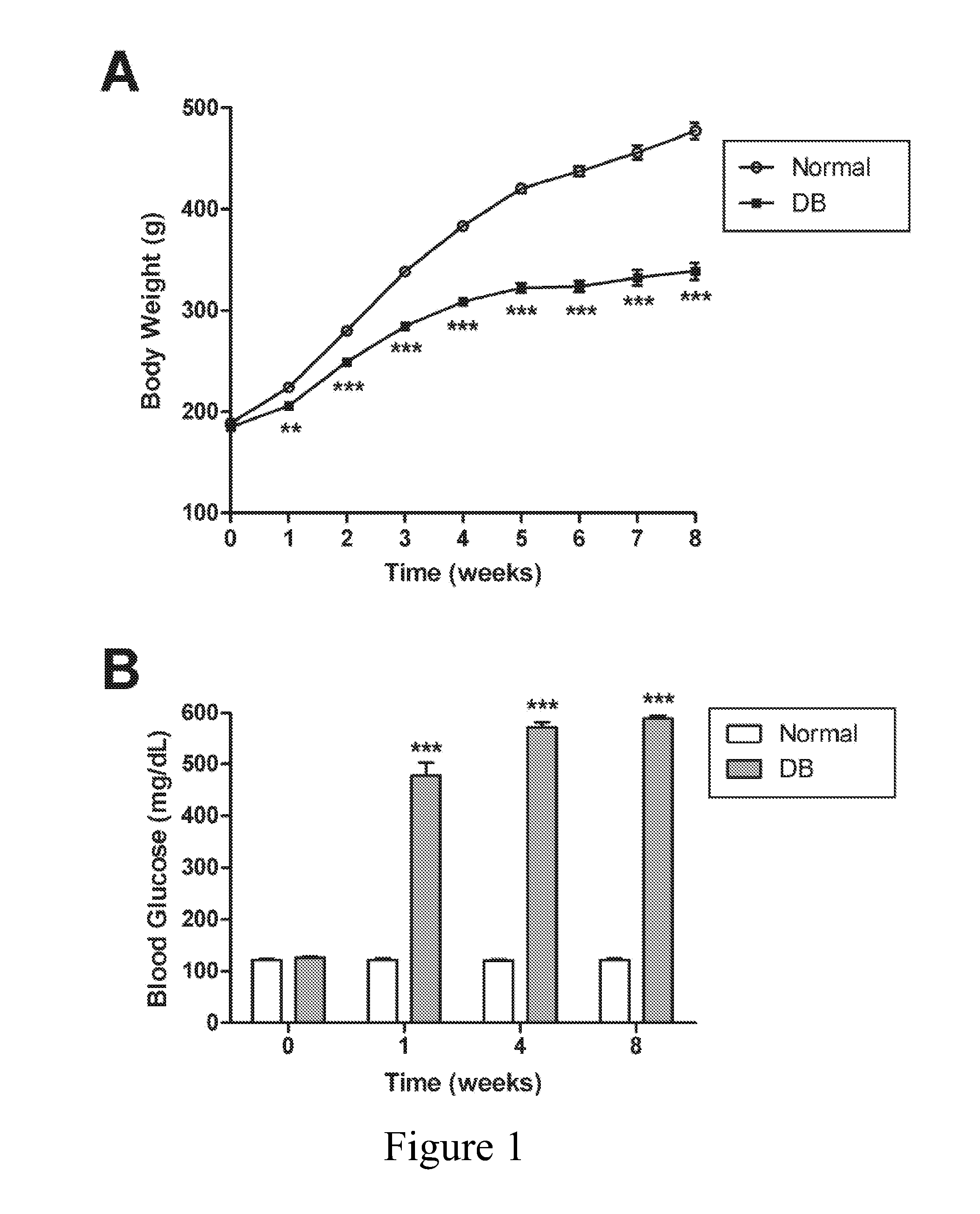Methods and compositions for treatment of epithelial wounds
a technology for epithelial wounds and compositions, applied in the field of epithelial wound treatment, can solve the problems of ineffective prevention or treatment of these complications
- Summary
- Abstract
- Description
- Claims
- Application Information
AI Technical Summary
Benefits of technology
Problems solved by technology
Method used
Image
Examples
examples
Materials and Methods
Animals and Induction of Diabetes
[0045]Male Sprague-Dawley rats (˜150 g) were purchased from Charles River Laboratories (Wilmington, Mass.), and housed under standard laboratory conditions; water and food were available ad libitum. All investigations conformed to the guidelines of The Pennsylvania State University College of Medicine Institutional Animal Care and Use Committee.
[0046]Type 1 diabetes (T1D) was induced by intraperitoneal (i.p.) injections of 40 mg / kg streptozotocin (STZ, Sigma, St. Louis, Mo.), on two consecutive days (Klocek et al., Journal of Ocular Pharmacology and Therapeutics, 23:89-102 (2007); Havel et al., Diabetes, 49:244-252 (2000)). This regimen produced insulin-dependent diabetes in 100% of the animals within 72-96 h; rats with blood glucose levels measuring >350 mg / dl were considered diabetic (DB). Blood glucose levels were monitored from the tail vein using a True Track® Smart System glucometer (Home Diagnostics, Ft. Lauderdale, Fla.) ...
experiment i
Naltrexone and Unwounded Skin
[0056]All rats were hyperglycemic within 72 h of STZ injection, with blood glucose levels for Normal and DB animals being 119±4 and 569±9 mg / dL, respectively (FIG. 1). The body weights of DB rats were reduced by 8% to 28% from Normal cohorts beginning 1 week after STZ injection and continuing throughout the experimental period (FIG. 1). Rats in the DB group were not provided with insulin. No animals died from hyperglycemia.
[0057]Relative to the BrdU labeling index of 8.1±0.3% in basal cells of the cutaneous epithelium of Normal rats, systemic injections of 30 mg / kg NTX by the i.p. or s.c. routes elevated BrdU labeling by 172% and 51%, respectively. With respect to a labeling index of 8.1±0.5% in the skin of animals with DB, i.p. and s.c. injections of NTX increased BrdU incorporation by 181% and 59%, respectively.
[0058]The effects of topical application of NTX (10−4 M to 10−6 M) dissolved in four different carriers that had different properties (e.g., ab...
experiment ii
Naltrexone and Full-Thickness Wounds
[0061]Based on the labeling index data from the first experiment, NTX at 10−5 M applied in two topical delivery systems, KYJ and MCN, was chosen for subsequent experiments examining the effects of opioid antagonist blockade on full-thickness wound healing. Normal and DB rats expressed body weight and glucose patterns similar to those in FIG. 1. All rats tolerated the wounding procedure without problems (e.g., normal food consumption).
Normal and Diabetic Wound Healing
[0062]Using a 6 mm trephine, the calculated wound size was 28.3 mm2, and wounds that deviated more than 10% were not included for analysis. Evaluation of wound closure in Normal and DB rats revealed that the area of residual wound in DB animals was 24%, 44%, and 132% greater on days 5, 7, and 9 following surgery relative to those of Normal rats (FIG. 5A).
Number of Applications of NTX and Efficacy of Wound Healing
[0063]To examine the effects of topical application of NTX on the healing ...
PUM
| Property | Measurement | Unit |
|---|---|---|
| thickness | aaaaa | aaaaa |
| diameter | aaaaa | aaaaa |
| diameter | aaaaa | aaaaa |
Abstract
Description
Claims
Application Information
 Login to View More
Login to View More - R&D
- Intellectual Property
- Life Sciences
- Materials
- Tech Scout
- Unparalleled Data Quality
- Higher Quality Content
- 60% Fewer Hallucinations
Browse by: Latest US Patents, China's latest patents, Technical Efficacy Thesaurus, Application Domain, Technology Topic, Popular Technical Reports.
© 2025 PatSnap. All rights reserved.Legal|Privacy policy|Modern Slavery Act Transparency Statement|Sitemap|About US| Contact US: help@patsnap.com



